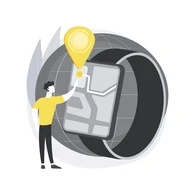
AI isn’t just a buzzword splashed across tech headlines anymore—it’s sitting in the middle of small business boardrooms, sales huddles, and even those 7 a.m. coffee chats where someone blurts out, “Can ChatGPT actually write our proposals?” The short answer: yes, but that’s not the whole story.
What’s fascinating is how small business leaders are starting to separate the hype from the hard value. And the lessons they’re learning? They’re surprisingly practical.
Lesson One: AI Isn’t Here to Replace People
Here’s the thing—many owners and supervisors started with a fear-based question: “Will AI take away jobs?” What they’re realizing instead is that AI, when used well, amplifies human work rather than erases it.
Think about scheduling. Tools like Motion and Clockwise can free up hours every week by automating calendar chaos. That doesn’t mean an assistant is irrelevant—it means that assistant now has more time to focus on higher-value tasks like employee development approaches or client relationships.
It’s the subtle shift from replacement to reinforcement. Leaders are learning that AI doesn’t take over people; it takes over the parts of work people never liked doing anyway.
Lesson Two: AI Is Only As Good As the Questions You Ask
You know what? This one stings. Many managers are finding out that asking a tool like ChatGPT or Jasper for “marketing ideas” spits back a generic list. But when they feed it company-specific context—say, the last campaign that flopped or the kind of customer reviews they’ve been getting—the answers suddenly feel tailored.
It’s a bit like mentoring a junior employee. The quality of their output hinges on how well you set the stage. Small business leaders are getting better at prompt engineering—though most don’t call it that. They just know that the more context they give, the smarter the AI seems.
Lesson Three: Professional Voice Cloning Is Catching Attention
Now here’s a curveball. One area leaders didn’t expect to explore is professional voice cloning. Imagine a small accounting firm where the founder records a quick audio note for clients each week. Instead of manually doing it every Friday, AI generates the message in their voice, polished and ready.
It saves time, keeps the personal connection alive, and scales outreach. But leaders are also bumping into governance questions—who owns the “voice” if the founder sells the business? What happens if that voice is misused?
This is where the conversation shifts from shiny tools to responsibility. Many small business owners are realizing that AI isn’t just about efficiency; it’s about ethics too.
Lesson Four: AI Isn’t Plug-and-Play—It Needs Training
A lot of teams assumed AI would be like installing a new printer—plug it in, push a button, and voila. But AI works differently. It requires context, tuning, and yes, sometimes trial-and-error.
One retailer I spoke with started using AI to predict inventory needs. At first, the numbers were all over the place. Only after weeks of feeding it seasonal data—past spikes during Diwali, slower movement in monsoon months—did the predictions actually become useful.
The lesson? AI’s not a magic wand. It’s a tool that learns best when businesses are patient enough to teach it.
Lesson Five: Employees Need to Be Part of the Journey
Leaders are also discovering that dropping AI into the workplace without explanation creates suspicion. Workers start whispering, “Are we being replaced?”
But when leaders involve their teams—showing how AI can cut tedious tasks, reduce errors, or even suggest smarter ways to handle customer tickets—it flips the narrative. AI becomes a partner, not a threat.
Some are even tying AI adoption into employee development approaches. Instead of only training staff on soft skills or leadership, they’re introducing “AI literacy” as part of the curriculum. That shift says a lot: AI isn’t just for the tech team anymore—it’s part of everyone’s toolkit.
So, What’s the Real Takeaway?
Small business leaders aren’t treating AI like a crystal ball or a silver bullet. They’re treating it like a Swiss Army knife: useful in dozens of small but meaningful ways—automating follow-ups, drafting proposals, predicting sales, even cloning voices responsibly.
They’re also learning that governance matters. AI brings efficiency, but it also raises new responsibilities around ethics, employee engagement, and customer trust. And trust, as every leader knows, is a fragile currency.
Here’s the big reveal: the leaders who succeed with AI aren’t the ones who chase every flashy tool. They’re the ones who stay curious, keep testing, and loop their teams into the learning curve.
Because AI isn’t just a technology story. It’s a people story. And that’s a lesson worth remembering.











Comments ( 0 )